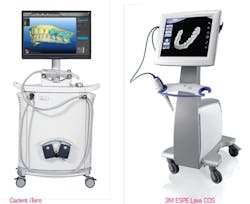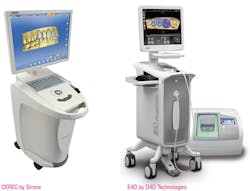Why Digital Impressions?
By Dr. Curt Mitchem
The field of digital impressions is quickly growing, as evidenced by the number of new scanner systems with more features and benefits. I will discuss the four major systems on the market and others that should soon be available. I will also give cost comparisons of digital impressions vs. conventional impressions.
There are basically two types of scanners on the market today. There are systems that use blue LED (light-emitting diode). These systems are optical scanners that depend upon a reflective surface and require a contrasting medium or powder to acquire a representation of the tooth morphology. There are also systems that use laser technology to scan and measure distances from the tooth surface to acquire the image. They do not require powder.
There are four major systems on the market today — Cadent iTero, 3M ESPE Lava COS, CEREC by Sirona, and E4D by D4D Technologies.
The Cadent and 3M ESPE machines produce models that are sent to the lab to produce the restoration of choice. Sirona and D4D include milling units for immediate fabrication of the final restoration chairside.
The CEREC AC can be used for fabrication of a model-only system by purchasing it without the milling center. It uses a blue LED optical scanner and requires the use of powder. Dental anatomy created by Lee Culp, CDT, is used for the occlusal design.
E4D’s system includes the interoffice milling center to produce same-day single crowns using Culp’s database of dental anatomy as well. The difference is that E4D uses a laser scanner and does not require powder.
E4D offers what it refers to as TSS or three sources scanning. This allows the dentist to directly scan intraorally, take a conventional impression, and scan the impression or pour the impression, and then scan the model.
Lava COS (chairside oral scanner) is a video-type format that uses the blue LED scanning system that requires powder. The downloaded scan information produces an SLA model that allows for fabrication of any type of restoration.
The iTero is an optically assisted laser scanner that does not require powder. The optics allow for real-time imaging. This allows seeing the model being built as you proceed through the scanning process. A milled model is produced, allowing for fabrication of restorative needs.
Glidewell has developed a scanning system that was introduced at the 2011 Chicago Midwinter Meeting. The system uses an optical scanning platform.
Modeling systems
Two types of modeling systems are used, which are SLA or stereolithography and milling. SLA is a rapid prototyping technology that produces an accurate model.
Milled models are produced using a pre-cured urethane block that is placed in a milling machine to remove excess material to accuracies within 20 microns. SLA produces models for CEREC and Lava COS, while Cadent uses milling to produce its model.
The labs like the virtual impressions because the information can be downloaded directly to their milling units to produce CAD/CAM restorations, such as e.max crowns that require no models. All of the systems eliminate stone model work so there are no distortion issues and no bubbles.
Cleaner preparations, improved accuracy of the models with virtually no remakes, and restorations that fit and require little occlusal adjustment result in big cost savings for the lab and dental office.
Digital advantages: With milled models, you have a solid model. Dies are precision-fit in the model with no movement, and all dies are captured in one model. This gives greater accuracy when restoring multiple units, such as veneer cases. There is no contamination from the patient and no die spacer is required.
Conventional advantages: The technique has been used for years, allowing for better initial understanding and comfort with the system.
Digital disadvantages: At this time, there are only two implant systems on the market that allow scanning of fixture level implants — 3I and Straumann. Zimmer and Astra believe they will have scannable abutments on the market soon. It is still difficult to scan a prepped tooth for a crown to fit an existing partial. It is difficult to make a crown to fit an existing partial no matter what system is used.
Conventional disadvantages: Expansion and contraction of PVS material and poured models. The possibility of bubbles, pulls, tears, and distortion while taking impressions can be routinely found. There is also the fragility of stone models that require repours with less accuracy.
I use the iTero, which allows me to control monthly impression costs, as do the digital systems. With iTero, I have an annual subscription fee of $4,000 for scans and service of the equipment. A doctor who averages 20 cases per month pays $16.66 per case ($4,000/12 months/20 cases).
For comparison, I used Extrude PVS material from Kerr that costs $18.72 per cartridge. I get two quadrant impressions per cartridge, plus the cost of mixing tubes, intraoral tip, light body PVS, and Blu Mousse bite registration. This resulted in an average cost of $16.51, which is comparable if there are no retakes. More cases mean increased impression material cost. With digital impressions, you have a decrease in cost per case when doing more cases.
I found TIME to be the real savings! With a conventional impression, including prep for packing the case for the lab, we averaged 35 to 47 minutes. With digital impressions, again we have prep time, but then we take only four minutes to scan both arches based on a quadrant impression. This comes to a total of 12 to 14 minutes, a difference of 23 to 33 minutes.
My crown seat time for conventional impressions was 15 to 20 minutes. For digital impressions, it was 10 to 15 minutes — a savings of another five minutes. This adds up to 28 to 38 minutes per crown prep.
My assistants do some of these functions and this means they’re not available to me for assisting. I admit I’ve become spoiled during the last 20 years and do not like to work alone. But anything that increases my efficiency and allows me to do more work in less time gets my attention.
This may not seem like much to some. So let’s put this into dollar amounts.
My hourly goal is $500 per hour or $8.33 per minute. For 28 minutes in time saved multiplied by $8.33, we have $233.24 in increased production time. We average 500 crowns a year. Multiplying this number by $233.24 results in $116,620 in increased production for the year.
We would realize more with the 38-minute savings. What we actually experienced in the first year of using digital impressions was more than a $129,000 increase in production. This was due mostly from the time savings we experienced. Some was due to the marketing of goopless impressions, as well as being seen as a progressive office and staying on the cutting edge of technology.
Like any equipment purchase, there is an initial cost. For iTero, Lava COS, and the CEREC AC scanner-only systems, you will spend from $20,000 to $30,000. For CEREC AC with milling center and the Schein E4D systems, you will spend from $110,000 to $120,000.
If you compare any of the systems to the increased production I experienced, you would still have a return on investment in less than a year. In my book, this is one of the many positives for digital impression systems.
Other time savings include tray selection, material dispensing, disinfection, and cleanup of the impression guns. There is no model pouring of the opposing models or model trimming and no distortion from the Triple Tray. Also, there is no more packaging the impressions, writing the lab script, or shipping since online prescriptions are sent electronically with the digital impression.
After I give anesthetic, the assistants typically fill in the lab script and scanning sequence, scan the opposing arch, and have the impression taken for the temporary. All this is done while I am doing hygiene exams.
Upon my return, we go right to work prepping teeth. There is no wasted time on my part. Again, this results in increased production and efficiency. As I mentioned earlier, the true savings with digital impressions is TIME!
The merging of Invisalign technology with iTero scans allows for quicker treatment without the need to take conventional impressions. Simply scan and send the digital impression. This allows for valuable practice growth opportunities.
Open systems, such as iTero, allow for seamless integration of the digital impression with cone beam CT data for enhanced implant and orthodontic treatment planning. This allows for the development of surgical guides and same-day temporization with predictable results. CEREC merges with the Galileos CBCT to allow for case design.
All restorative options are available, from single crowns to full-arch restorations. Veneers, implants, inlays, and onlays are possible. I have used digital impressions for five years, and cannot imagine going back to conventional impressions.
Curtis R. Mitchem, DMD, practices full time in Champaign, Ill. He is a fellow in the Academy of Dentistry International, and is active in the Illinois AGD. He will achieve Fellowship in the AGD in 2012. Reach him at [email protected].
Past DE Issues


